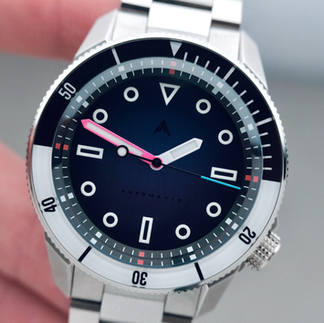Namica Shirahama MkII Ultra Blue
Exploring the Traditional Through the Modern
August 5, 2025
Things are such in the watch world today that we expect any watch to come with a long list of great specifications. We want them tough with professional-grade water resistance, abyss-like fluorescent application of luminescent compounds, accurate and easy-to-service movements, protected against everyday wear and tear through scratch-resistant crystals and reinforced alloys. And all for the smallest sums of money possible. And it has become quite easy to get all of this for a few hundred bucks which creates a new problem for brands: how to stand out from the busy crowd of micro/independent brands from a technical standpoint. And that problem is made even more so challenging to overcome because at the same time, we also demand from brands to come up with brand new designs so we can say we’re wearing an exceptional piece that would make for the perfect conversation starter. In other words: we want unique designs and the best of specifications for as cheap as possible. It’s quite silly and impossible to achieve.
What brands can do, however, is to offer one or the other in some form or another. On Mainspring we’ve looked at many models which are well equipped and which look good, or really beautiful and unique watches which have ok specs, or spec monsters that offer tremendous value but lack in the originality department perhaps. And of course, all of this takes place within a randomly self-imposed price bracket of roughly $150 USD to $3,000 USD which means that there is so much the brands we like can do without jumping into the luxury and mainstream horology in which we find anything and everything. (In the latter the manufacturing powers are pretty much limitless and vertical integrations of the means of production result in high-end watches sold for the price of mid-tier microbrand offerings.) In the midst of all of this, a few micro/indie brands such as Namica manage to strike the perfect balance between good mechanics and fine looks without reinventing all the wheels of horological design.
The Shirahama MkII is the perfect example of that.

Specifications
The first thing you should know about the Shirahama MkII is that there are five versions of it. Rather, five dial variations presenting different colors and layouts, but all sharing the same specs. Each and everyone of them deserves our full attention but on Mainspring I prefer to focus on one watch at-a-time and so I chose the Ultra Blue as it is the version of the Shirahama MkII that speaks the most to me. The other versions are: Neo Tokyo Evo (hollowed out hour markers and blue/purple fumé dial,) Cherry Blossom Candy (pink dial,) Cherry Blossom Kanji (pink dial with Kanji characters for the hour markers,) and Neo Blizzard (white dial and black accents.) For the record, I handled four of the five versions and each is neat in its own right. The second thing you should know about the Shirahama MkII is that it is a proper dive watch which can easily make a lot of other similar timepieces blush.
Alright, we also live in a world in which what is “proper” is debatable and where any piece of information I could share about any watch can be taken subjectively as being good or bad. However, we might agree that what follows does constitute a spec sheet which, generally speaking, is attributable to a solid/professional/decent/proper diver: 200 meters of water resistance (screw-down crown and case-back;) 120-click unidirectional bezel with a sapphire insert; excellent applications of BGW9 lume on the hands, markers, and all bezel markings; a sapphire crystal with blue inner anti-reflective coating; a stainless steel bracelet with tool-less micro-adjustment mechanism, quick-release spring bars, and screwed links. Moreover, the caliber is a Miyota 9039 no-date powerhouse ticking at 4Hz and coming with 42 hours of power reserve. So far pretty much what constitutes a proper diver, wouldn’t you say so?

Let’s put all of this within a financial context before we continue. The Shirahama MkII is available starting today for $529 USD on a rubber strap and $599 on a bracelet. These prices will increase tomorrow and again after that the pre-ordering campaign is over. (More on this in the conclusion.) But we can perhaps agree one more time that $529/$599 USD is fair for what you’d be getting. And there is a bit more. The crown is lightly guarded, located at the 4 o’clock, and covered with four rows of Clous-de-Paris machined knurking for easy grip and operation. And we find the same knurled pattern in two rows around the bezel for equally easy grip and operation. The clicks are audible, solid, and the bezel mechanism comes with the total absence of blackplay. Having a good bezel on a diver is important to many of us and so I wanted to let you know the bezel action is really good.
Lastly, the dimensions: 40 x 47 x 11.7mm and a 20mm lug width (the bracelet tapers to 16mm at the clasp.)

Design
So far we know and agree (of course) that the Namica Shirahama MkII Ultra Blue has good specifications and is a proper diver. But it is its design which makes it stand out from the busy crowd of microbrand divers and which will eventually make you pull the trigger or not on one. In a way, the Shirahama MkII doesn't reinvent the wheel in the sense that it doesn’t revolutionize the otherwise heavily codified aesthetics of dive watches. It has a legible and classically laid out dial, a functional bezel, average proportions for a modern submersible tool watch, and lume where it matters. But it is also endowed with unique dial colors proper to Namica, an angular case that is common for Namica to design (see our reviews on the first generation Shirahama and of the Okami for reference,) as well as a translucent-like construction of the sapphire bezel which is unique to Namica. Then we do have something rather special, don’t we?

Let’s take the dial as an example. As it was the case with the first generation Shirahama, it comes with a Squale-like handset—pencil-style hour and minute hands with the latter being painted in orange—, applied hour markers organized in a classic diver fashion—inverted triangle at the twelve, batons at the three, six, and nine, and circular elements everywhere else—and a clean minute track printed on an angled rehaut. Compared to the first gen, the dial is better laid out here as the markers are smaller and pushed further outward and that the hands are slightly thinner. Or it appears as though the dial opening is a tad wider which would explain the above and that the newly shaped crystal with its intense chamfer make it so the minute track appears narrower. It’s hard to tell even for me looking at the photos I took of the Shirahama MkI almost four years ago. But the impression I have is that the dial is better laid out and looks more refined on the MkII.

The bezel insert made for a great talking piece on the first generation of Shirahama and it still does today. I love how the lume is printed positively on half of the bezel insert and negatively on the other half, meaning that from 15’ to 45’, the white portion is lume and that the 5-minute increment markers aren’t. (They are negatively printed.) Conversely, from 45’ to 15’ the lume is only present on the numerals, dashes, and triangle, dividing up the bezel in two distinct sections as it can be found on certain GMTs where the AM hours are highlighted in one colour whilst the PM hour are highlighted in another. The transition between the blue and white backgrounds are seamless on the Shirahama MkII and confer to that part of the watch a very clean and neat look, something we also get from the neatly organized dial and all of its applied and printed elements, and how both the dial and bezel blend in together so effortlessly.

Lasty, the case. Almost four years ago I wrote that the four o’clock positioning of the crown is very “Seiko” because this Japanese brand* pioneered this unique design feature (as far as I know that is.) But today I’ve seen it on so many tool watches coming from the micro/independent watch market that I now see it as being a trait of that sub-section of the watch world. So the crown is tucked away and semi-guarded, visually striking for its intense Clous-de-Paris knurling and fully polished treatment, an amazing spectacle we also find on the bezel insert. The case is both angular at the lugs and slab-sided at the flanks, and because the bezel aligns perfectly with the sides, the watch appears to be only made of lugs and bezel. It is mostly brushed save for tiny polished chamfers on the lugs, and the case flows in naturally with the Hexad bracelet, a name that stems from the six-sided links.
*Namica is based in Japan.

The Heart of the Matter
The situation is such that we continue to have an appreciation for dive watches (and a passion and even an obsession for some…hum hum) and so brands continue to give us dive watches. And because there are so many of them on the market today, then brands must find ways to distinguish their offerings from those offered by the thousands of other brands which are conjointly partaking in the proliferation of this genre of timekeeping devices. But, as noted in the introduction, it is becoming more and more common to find spec monsters available for a few hundred bucks, so that ain’t something that in and of itself can set one brand apart from another. (Sadly for them.) And so some turn to the conceptual and avant-garde designs irreverent of specs, morphing the idea of a straight-forward tool watch into that of a personal statement or design object that is far removed from its initial raison d’être.

At the heart of the matter today then is the fact that the Namica Shirahama MkII Ultra Blue (and all of its siblings) does strike the perfect balance between looks and mechanics, offering something that is visually different but not strange or outlandish—by repurposing the classical design codes of dive watches established in the 1950s—which is paired with professional-grade specifications which give many of us the reassurance that the Shirahama MkII’s will handle themselves well in any situation we would find ourselves in. So they remain tool watches with classic proportions and commonplace specifications, but at their core they make a statement: that is is alright to revisit traditional horology through a modern lens, to take this hobby/obsession/personal adventure with light-heartedness and fun, and that it is possible to do something different without having to be too “out there.”

Conclusion
All five versions of the Shirahama MkII’s are available starting today, August 5, 2025, at the discounted price of $529 USD on a rubber strap and $599 USD on the bracelet. Then from August 6 through August 19th, prices will go up to $549 and $629 USD respectively, with a full retail price afterwards of $600 USD and $675 USD still respectively. Namica estimates to deliver the watches in December of 2025 so that would make for a perfect self-indulged early Christmas gift! For these prices, specifications, and designs, I would be hard-pressed to find a better option on the market today which combines this level of robustness with such a high degree of fun. Namica does both very well and found its own way to make a dent in this oversaturated market.
Thanks for reading.














































